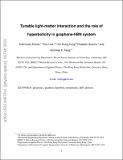| dc.contributor.author | Low, Tony | |
| dc.contributor.author | Fung, Kin Hung | |
| dc.contributor.author | Avouris, Phaedon | |
| dc.contributor.author | Kumar, Anshuman | |
| dc.contributor.author | Fang, Xuanlai | |
| dc.date.accessioned | 2017-07-07T17:16:28Z | |
| dc.date.available | 2017-07-07T17:16:28Z | |
| dc.date.issued | 2015-04 | |
| dc.date.submitted | 2015-01 | |
| dc.identifier.issn | 1530-6984 | |
| dc.identifier.issn | 1530-6992 | |
| dc.identifier.uri | http://hdl.handle.net/1721.1/110539 | |
| dc.description.abstract | Hexagonal boron nitride (hBN) is a natural hyperbolic material, which can also accommodate highly dispersive surface phonon-polariton modes. In this paper, we examine theoretically the mid-infrared optical properties of graphene–hBN heterostructures derived from their coupled plasmon–phonon modes. We find that the graphene plasmon couples differently with the phonons of the two Reststrahlen bands, owing to their different hyperbolicity. This also leads to distinctively different interaction between an external quantum emitter and the plasmon–phonon modes in the two bands, leading to substantial modification of its spectrum. The coupling to graphene plasmons allows for additional gate tunability in the Purcell factor and narrow dips in its emission spectra. | en_US |
| dc.description.sponsorship | National Science Foundation (U.S.) (CMMI-1120724) | en_US |
| dc.description.sponsorship | United States. Office of Naval Research. Multidisciplinary University Research Initiative (FA9550-12-1-0488) | en_US |
| dc.language.iso | en_US | |
| dc.publisher | American Chemical Society (ACS) | en_US |
| dc.relation.isversionof | http://dx.doi.org/10.1021/acs.nanolett.5b01191 | en_US |
| dc.rights | Article is made available in accordance with the publisher's policy and may be subject to US copyright law. Please refer to the publisher's site for terms of use. | en_US |
| dc.source | arXiv | en_US |
| dc.title | Tunable Light–Matter Interaction and the Role of Hyperbolicity in Graphene–hBN System | en_US |
| dc.type | Article | en_US |
| dc.identifier.citation | Kumar, Anshuman; Low, Tony; Fung, Kin Hung; Avouris, Phaedon and Fang, Nicholas X. "Tunable Light–Matter Interaction and the Role of Hyperbolicity in Graphene–hBN System." Nano Letters 15, 5 (April 2015): 3172–3180 © 2015 American Chemical Society | en_US |
| dc.contributor.department | Massachusetts Institute of Technology. Department of Mechanical Engineering | en_US |
| dc.contributor.mitauthor | Kumar, Anshuman | |
| dc.contributor.mitauthor | Fang, Xuanlai | |
| dc.relation.journal | Nano Letters | en_US |
| dc.eprint.version | Original manuscript | en_US |
| dc.type.uri | http://purl.org/eprint/type/JournalArticle | en_US |
| eprint.status | http://purl.org/eprint/status/NonPeerReviewed | en_US |
| dspace.orderedauthors | Kumar, Anshuman; Low, Tony; Fung, Kin Hung; Avouris, Phaedon; Fang, Nicholas X. | en_US |
| dspace.embargo.terms | N | en_US |
| dc.identifier.orcid | https://orcid.org/0000-0002-7433-8341 | |
| dc.identifier.orcid | https://orcid.org/0000-0001-5713-629X | |
| mit.license | PUBLISHER_POLICY | en_US |
| mit.metadata.status | Complete | |
